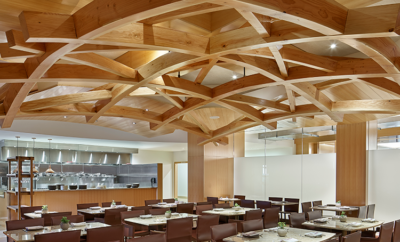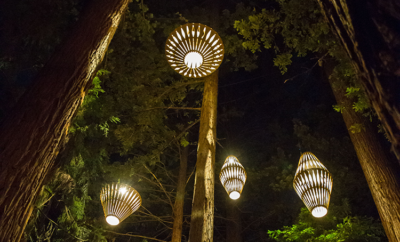 Photography by Robin Hill
Photography by Robin Hill
Feature
Nature and Nurture
LEONARD AND JAYNE ABESS set out to build a family compound that could be a legacy, that would mark family traditions for future generations, but that was not the full extent of their aspirations. They have also preserved a significant hardwood hammock in the Florida Keys, and though Leonard once called himself “an accidental collector,” they have filled their house—a sequence of pavilions nestled gently into the landscape—with important (and quite beautiful) furniture from both George Nakashima and his daughter Mira. This is a place where nature is revered, honored, and celebrated.
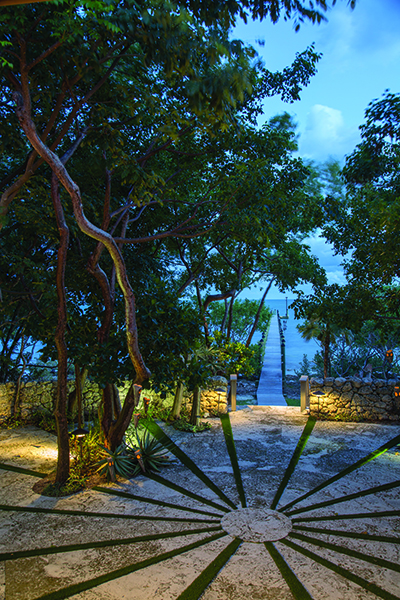
The Abess family mandate to artist Michele Oka Doner when she designed their east-facing Sunrise Terrace in local cut keystone was that she could not move a tree. The wall at the edge was made by Vermont stonemason Benjamin Fuller, who used the age-old method of building without mortar.
On any given winter or spring weekend you might find three generations of Abesses, along with assorted family dogs, gathered around the large and really quite extraordinary dining table made from a single slab of Claro walnut by Mira Nakashima, and, chances are, that the windows and doors are open, welcoming the subtropical breezes. Or they might be scouring for shells or turtle bones along the ocean’s edge or sitting in solitude in the “Shaman’s Hut” that the artist Michele Oka Doner fashioned for them from an eighty-year-old hurricane shelter.
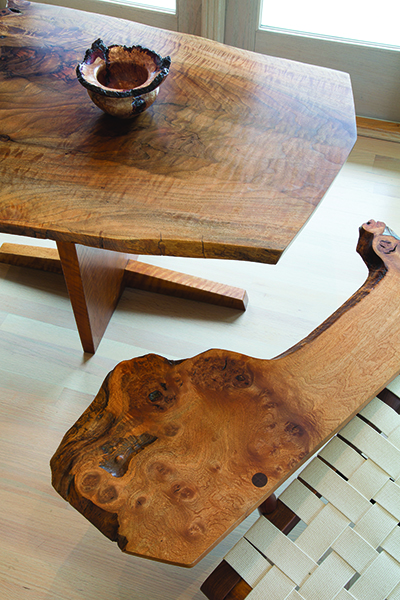
A George Nakashima Minguren I end table (1971) and Long chair with an English oak burl arm (1965) furnish the study in one of the connected pavilions that make up the family compound in the Florida Keys.
None of this can be seen from the water; trees form a kind of scrim, filtering the view. The hardwood hammock (it is basically a coastal tropical forest) separates the compound from the roadway to the west. In many ways, it is an island within an island. “Most people want a beach house,” says son Matthew, an independent curator and part of the second generation, “but my parents built a ‘tree house.’ ”
For Leonard Abess, trees are a passion and a pursuit. An entrepreneur and former banker, he is a known conservationist who cultivates a wide range of trees. Jayne Harris Abess, a long-time weaver with a strong interest in the arts, led the family to assemble its extraordinary collection of Nakashima. Together Leonard and Jayne have bought and commissioned art that, for the most part, speaks to their interests and passions, and includes major works by Ursula von Rydingsvard and Michele Oka Doner, as well as John James Audubon (Florida birds), João Barbosa Rodrigues (tropical palms), Clyde Butcher, Esther Shalev-Gerz, George Rickey, and Miami artist Eugene Massin.

The Abess family mandate to artist Michele Oka Doner when she designed their east-facing Sunrise Terrace in local cut keystone was that she could not move a tree. The wall at the edge was made by Vermont stonemason Benjamin Fuller, who used the age-old method of building without mortar.
As Jayne tells it, she had been looking at Nakashima from a distance—books, magazine and newspaper clippings, and more. Then Matthew (he is the middle child of three with an older sister, Ashley, and a younger brother, Brent) went to the University of Pennsylvania, which put them in Nakashima territory. They managed to secure an appointment with Mira (though there was a long waiting list), in part because they wanted a very big dining table, and at that particular moment she had the right wood for it; they traveled to the studio in New Hope, Pennsylvania, to pick out the exact slab and were able to commission dining chairs from the same tree. During the same time period, they grew to know Robert Aibel, whose Moderne Gallery in Philadelphia is a leading source for works by George Nakashima.

Two large-scale cedar and graphite sculptures by Ursula von Rydingsvard, Amelia and Five Cones, stand next to the dramatic glass staircase in the foyer of the main house.
Aibel says the Abesses were avid learners with a natural ability to choose great design, building their “accidental” collection of historic pieces by George and newly commissioned ones from Mira, who has run her father’s studio since his death in 1990. In the course of numerous visits to both the Nakashima studio and Moderne Gallery, they also bought sofas, bedsteads, and tables to fill the large, airy open living spaces in the Florida compound. They were not buying precious objects to admire from a distance. Grandchild Jacob clambers up on the chairs to read or sit; the smaller dogs seize lap-sitting opportunities. “Mira makes it very clear that these pieces are made to be used. They will get scratched, and they will get stained, but it’s all part of the process,” Leonard says.

A pair of George Nakashima Armless Cushion settees (1969) with Jack Lenor Larsen fabric form a seating area in the living room, in front of George Rickey’s Four Squares Diagonal. Eight Mira high chairs by Mira Nakashima flank the countertop eating space in the kitchen.
Adds Aibel: “Jayne and Leonard began to buy Nakashima pieces because of a true passion for trees, very much akin to what led George to develop his furniture designs—based on his respect and love for wood. What I love about the way that the Abesses made decisions concerning what to purchase is that it falls in line with the origins and continuity of Nakashima’s success—people bought pieces to use. Yes, they were beautiful, but they needed them in their homes, and they were part of everyday life. The Abesses built a fantastic collection, but it’s wonderful that it totally grew from a practical need, and everything serves an important functional purpose.”

The art in the guest house includes Michele Oka Doner’s cast-bronze sculpture called Root. The living room features a George Nakashima Conoid dining table and chairs (1984) as well as a pair of his English walnut and rosewood Kornblut cases (1984) and a Conoid room divider (1984) behind the lounge chairs. The seating comprises George Nakashima’s Cushion lounge chairs (1987) and a pair of Armless Cushion settees. The bed was made by Jeff Scurlock from a fallen woman’s tongue tree.
A long saga led to the acquisition of the land, one of the last and most important tropical hardwood hammocks in the Keys. The Abesses found the site more than twenty years ago and were about to buy it when they discovered that the necessary permits were not in place, and more, the only access was through the woods, which meant cutting down trees. And Leonard Abess does not like to cut down trees. Fast forward a few years, and the same ten-acre plot came up for sale again, this time with a driveway already cut through the woods, sparing Leonard the heartache of having to cut through the property. They bought it, though not without some bidding drama. Some years later, they were able to add eight more contiguous acres to bring the total to eighteen. (They subsequently placed a conservation easement on all but five acres.)
A side note here: coastal hardwood hammocks are rare, as they have been destroyed piece by piece, lot by lot, acre by acre for waterfront homes; and yet they play a vital role in many ways, ranging from providing a habitat for flora and fauna not found elsewhere to being an all-important way station for migratory birds. Biologist Susan Sprunt points out that a typical Florida Keys hardwood hammock has five to six times the plant diversity of a northern forest.

The Minguren I end table and Long chair with an English oak burl arm are nestled in a corner of the study, along with two additional pieces by George Nakashima, a Cross-Legged desk, and a Kent Hall lamp with a walnut-root frame and rice- paper shade.
To build on this precious land, the Abesses turned to an old family friend, James Merrick Smith, and his partner, Hal Burchfield. Smith, who died in 2013, was among Miami’s early modernists, though his work was largely in interiors; he had been the primary designer for the family-owned City National Bank of Florida, Leonard notes, adding, “and heck, he designed my bedroom when I was eight years old.” There were some givens: the footprint on the land had to be as light as possible, sparing the trees, and all doors and windows had to be operable. Despite dreams of old-fashioned timber construction, a stronger structure that also used concrete and steel (and had a five-layer metal roof) made much more sense. Rather than a typical plan in which rooms connect, they opted for a series of connected pods and freestanding pavilions. The main living space is vast and column-free. Later, Ali and Elahe Sareh—former employees of Smith and Burchfield—designed both a guesthouse and an open-air pavilion which is constructed in part from rare recycled Dade County pine Leonard discovered in the roof of a warehouse he owned in Miami and was about to demolish. “I was staring at the roof and said, ‘wait,’ ” Leonard recounts. The thirty-thousand-square-foot warehouse roof was then taken apart truss by truss.
A freeform stone wall, constructed out of the indigenous coral rock, defines paths through the property. The Abesses, who also live in Miami and Vermont, are great admirers of the stone walls of New England. Thus they persuaded Benjamin Fuller, a stonemason from Vermont, to spend a year in the Keys working with the comparatively porous coral stone, building the wall traditionally, without mortar. “We told him he couldn’t cut down any trees,” Jayne says, “so the wall meanders.” He also inserted found objects—air plants, shells, and more—as surprises in the wall.

A loggia with mahogany doors faces east and opens onto the pool and a stand of native mangroves, with the Atlantic Ocean beyond.
A concrete-block hurricane shelter, constructed in 1936, a year after the most vicious hurricane in Keys history, sat at the southerly end of the property (the second and less pristine eight-acre swath had remnants of a long gone earlier development). Inspired to keep it, the Abesses turned to Oka Doner, a longtime friend, who in turn proposed encasing it with a vine-entwined trellis that would become home for cactus and flowering epiphytes such as vanilla orchids—“a cacophony of fertile growth [that] will lend a decidedly feral quality to the tower,” she said, thus blurring the line between the natural and the man-made. Inside what would come to be called the Shaman’s Hut (“they wanted a sacred space,” says Oka Doner) are a bronze Burning Bush candelabra by Oka Doner and a growing number of talismans— turtle bones, shells, driftwood, and other found objects. Most recently, totally unprompted, Jacob (who is not yet two years old) added turtle bones he and the family dog Scarlett found at the water’s edge.
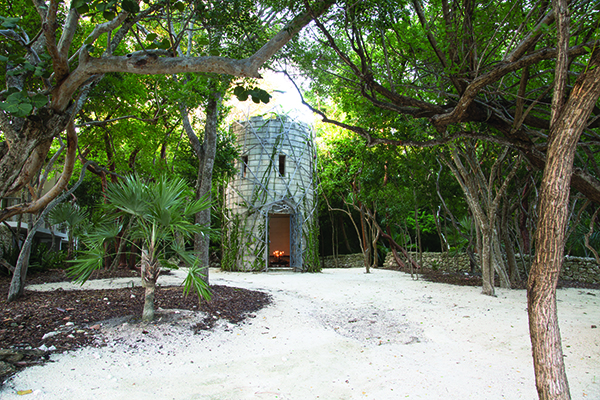
Michele Oka Doner’s Shaman’s Hut converted a 1936 hurricane shelter into a place of spiritual refuge. The exterior is wrapped in vines and epiphytes attached to a trellis.
Oka Doner also designed what is now called the Sunrise Terrace of coral rock and zoysia-grass in front of the guesthouse; not surprisingly, her charge was to leave all the trees in place and design around them. She also created a large bronze “spider” that hangs on the guesthouse wall. It is actually a casting of a remarkable tree root found on the property and stands in perfect counterpoint to Ursula von Rydingsvard’s outsize cedar and graphite Spoon Ladle with Bent Handle, a recent purchase by the Abesses. A bed in the guesthouse—one of the non-Nakashima pieces in the compound— was made by the Keys-based wood turner Jeff Scurlock from a woman’s tongue tree (Albizia lebbeck) that had fallen; still other pieces— tables, a bar, and cabinetry—were made by Rich Scharnagl. The handmade bench in the Shaman’s Hut is by Miami furniture maker Austin Kane Matheson.
Which comes back to the trees. Leonard Abess estimates that there are as many as one hundred species on the property (it is too densely wooded to do an accurate count, and, he says, “we care for the hammock by leaving it alone”), among them gumbo limbo, mahogany, Jamaican dogwood, pigeon plum, and lignum vitae. “It is a very special ecosystem not found anywhere else in the world, and I happen to have the privilege of being the caretaker of it.”


